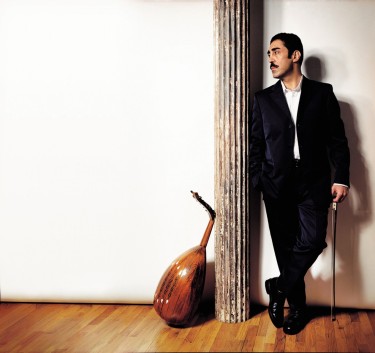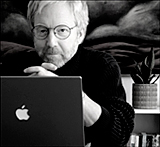Simon Shaheen at Sixth & I Historic Synagogue
By Stephen Brookes • The Washington Post • February 8, 2015
Simon Shaheen, the much-admired Palestinian violin and oud virtuoso, brought his ensemble to the Sixth & I Historic Synagogue on Saturday night for a concert that fused traditional Middle Eastern music with everything from jazz to flamenco to Indian ragas. That may sound like a recipe for the soggy, superficial mush that often gets passed off as “world fusion” music, but the evening turned out to be a probing, personal and convincing exploration of the currents that run through different musical traditions — and tie the ancient past to the 21st century. Shaheen has long been at the forefront of new Arabic music, and much of the evening was devoted to his own compositions, from a medley built around “Saraab” (an atmospheric work that evokes mirages and the slow, rolling rhythms of a caravan through the desert) to the jazzy, flamenco-flavored “Al-Qantara.” Arabic to its core, steeped in tradition but unconstrained by it, Shaheen’s music seemed always to be reaching into history to discover the meaning of the present — and the beauty it found there was striking. Bassam Saba’s captivating, shape-shifting improvisations on reed flute in “Saraab” were poignant in an almost otherworldly way, and the improvisations (known as “taqasim”) by all the players — particularly Shaheen’s brother Najib on oud — favored subtlety and expressiveness over mere displays of virtuosity.
Shaheen has long been at the forefront of new Arabic music, and much of the evening was devoted to his own compositions, from a medley built around “Saraab” (an atmospheric work that evokes mirages and the slow, rolling rhythms of a caravan through the desert) to the jazzy, flamenco-flavored “Al-Qantara.” Arabic to its core, steeped in tradition but unconstrained by it, Shaheen’s music seemed always to be reaching into history to discover the meaning of the present — and the beauty it found there was striking. Bassam Saba’s captivating, shape-shifting improvisations on reed flute in “Saraab” were poignant in an almost otherworldly way, and the improvisations (known as “taqasim”) by all the players — particularly Shaheen’s brother Najib on oud — favored subtlety and expressiveness over mere displays of virtuosity.
Some of the most provocative music, though, came when the young sarod player Sashank Navaladi joined the ensemble for improvisations with Shaheen on two Indian ragas. The Raag Jhinjhoti and the Raag Rageshri are both late-evening ragas, and Shaheen (first on oud and later on violin) opened by trading dark, brooding lines with Navaladi. As the pace slowly picked up, the music seemed to shift away from Indian traditions and toward those of the Middle East — drawing, with great naturalness and insight, a connection between the two.
That sense of connection — and of deep authenticity — was the hallmark of the evening, which included works by such notable Arab composers as Mohammad Al Qassabji, whose “Zikrayati” was both elegant and deeply expressive. But it may have been the fiery closing finale by Egyptian composer (and oud player) Riyad al-Sunbati that provided the most excitement of the evening — and brought the audience to a standing ovation.


Reader Comments